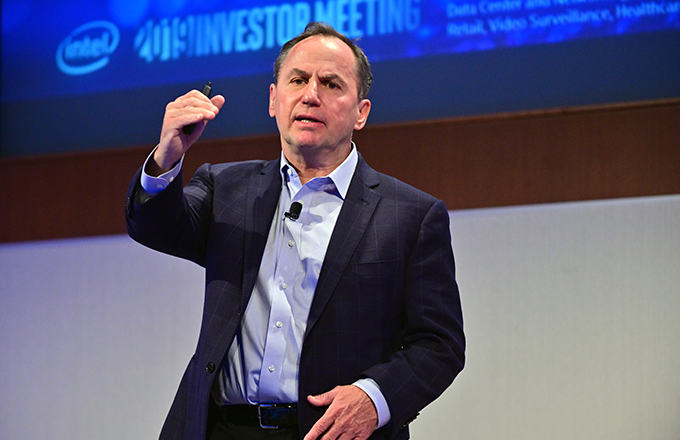 INFRA
INFRA
 INFRA
INFRA
 INFRA
INFRA
Intel Corp. is finally ready to begin shipping its 10-nanometer processors in large volumes after years of delays.
At its annual shareholders meeting today, the semiconductor giant said its first 10nm Ice Lake processors would be ready to ship in June, though it’s not clear when the first laptops based on the new technology will become available.
Still, it may well be worth the wait. Intel touts its future Corei7 quad core central processing units based on the 10nm process as having twice the graphics performance of its current 14nm chips, double the video transcoding speed and three times as much artificial intelligence compute power.
The company said it will release “multiple” 10nm chips throughout the rest of this year and next, including a general-purpose graphics processing unit, and specialized chips such as field-programmable gate arrays and its AI-focused Nervana processor. Data center server chips, which are a big part of Intel’s plans going forward, will debut in the first half of 2020, the chipmaker said.
Perhaps the bigger news, though, is that Intel has set a concrete deadline for the arrival of its first 7nm processors. It says its first product based on the smaller and denser technology will be an Xe-based general purpose CPU that’s expected to launch in 2021. The performance gains will be much more significant, Intel has promised, with a performance-per-watt boost of about 20%.
The 7nm chips will also incorporate Extreme Ultraviolet Lithography technology, which uses shorter wavelengths of light to transfer information across silicon and could potentially lead to more performance gains. The new technology will enable the company to increase the transistor density of its chips significantly while optimizing their power consumption. Intel said the EUV technology will also be the basis of multiple generations of chips based on even smaller manufacturing processes.
Analyst Holger Mueller of Constellation Research Inc. told SiliconANGLE that Intel is under pressure to execute on its move to a 7nm process, especially considering the delays it faced in getting to 10nm. However, he said the immediate focus should be on finalizing its move to 10nm first.
“It would be better for enterprises if Intel succeeds in this as it will keep processor costs down, which is critical given the CPU-intensive loads required by AI and machine learning technology that powers most next generation apps,” Mueller said.
During the investor meeting, Intel Chief Executive Officer Bob Swan (pictured) told shareholders the company’s 7nm process is key to the company’s ambition of regaining leadership in the chip manufacturing process. However, the CEO reiterated his belief that “product leadership” is more important as the company targets a much larger market for its processors.
Swan said the company is eyeing a 28% share of what he says will be a $300 billion addressable market for computer chips by 2023, which would amount to about $85 billion in sales. That market includes things such as CPUs, GPUs, FPGAs and possibly even 5G chips and specialized processors for AI and autonomous vehicles, the executive said.
“We believe in an expanded market opportunity we can play a bigger role in the success of our customers,” Swan said. “Our emphasis is on improving execution, accelerating innovation and evolving our strong culture while making disciplined investments in pursuit of profitable growth.”
That $300 billion market is a pretty large one, but whether or not it’s big enough to satisfy Intel’s investors remains to be seen. Swan told shareholders that he expects both the company’s revenue and earnings per share to grow in the “single-digit” percentage range over the next three years. PC chip sales are likely to remain flat in that period, but data center chips should see double-digit growth, he said.
Swan also said Intel’s operating margins would remain at a steady 32% over the next three years, though gross margins would decline as it ramps up production of its 10nm chips.
“The $300 billion addressable market is much larger than the previous $100 billion market Intel participated in five years ago, so I see this as a positive, not a negative,” said Patrick Moorhead, an analyst with Moor Insights & Strategy.
But Intel’s shareholders were clearly hoping for more impressive numbers, as the company’s stock fell by 2.5% in late trading Wednesday following the presentation.
The stock drop was likely sparked by concerns about the sheer scope of Intel’s plans going forward and doubts over whether or not it’s really up to the tasks it has set itself, Charles King of Pund-IT Inc. told SiliconANGLE.
“Given the pains of the past couple of years, including the dismissal of Brian Krzanich, ongoing delays in 10nm process tech, and the collapse of its 5G partnership with Apple, some caution is probably warranted,” King said. “But at the same time, Intel has steadily demonstrated singular business and technical leadership qualities for decades. The company has stumbled before but over time, righted itself and regained its balance and prominence. I expect that will be the case this time around, too.”
Support our mission to keep content open and free by engaging with theCUBE community. Join theCUBE’s Alumni Trust Network, where technology leaders connect, share intelligence and create opportunities.
Founded by tech visionaries John Furrier and Dave Vellante, SiliconANGLE Media has built a dynamic ecosystem of industry-leading digital media brands that reach 15+ million elite tech professionals. Our new proprietary theCUBE AI Video Cloud is breaking ground in audience interaction, leveraging theCUBEai.com neural network to help technology companies make data-driven decisions and stay at the forefront of industry conversations.